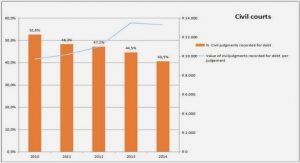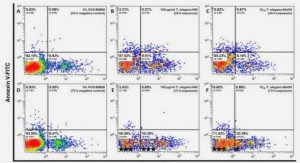Get Complete Project Material File(s) Now! »
Computer simulations
Raytracing software is commonly available and is mainly based on the Monte Carlo Multi-Layered (MCML) programs developed by Jacques (Jacques SL, 2008(a)). The software is downloadable online (Prahl S, 2007(b)). These programs use the Monte Carlo raytracing techniques where ‘photons’ or ‘rays’ are traced through a medium with pre-defined absorption and scattering properties, until the photons are completely absorbed or leave the medium through the boundaries of the model (Breault Research, 2006), (Breault Research, 2007).
The Advanced Systems Analysis Program (ASAP®) from Breault Research, a commercial software package, with the advantage of allowing the user to easily make geometry changes to a tissue model, was used for this work. Different tissue geometries and tumours (e.g. layered structures, spheres and uneven surfaces) can be simulated in the software. Due to a lack of scientific publications making use of this software for modelling the interaction of light with skin tissue, this paper tries to verify the model with the use of custom made tissue simulating phantoms that can be measured in an optical laboratory. Before any laser treatment can progress to clinical trials, the safety of the treatment needs to be established. This model will be able to calculate the fluence rate at any given distance into the skin to ensure that safety standards and treatment parameters are met. The final aim of this work will be to model the absorption of laser light as it passes through skin tissue in the presence of a small tumour and the drug used in photodynamic therapy, a form of cancer therapy. In the model the geometry of the phantom was described. A light source was created and traced though the sample. ASAP is in essence a non-sequential raytracing software package, which means that a ray interacts with the optical surfaces as they are encountered. Rays are allowed to split due to Fresnel reflections. ASAP ceases to trace a ray if its fluence rate has become too low. In ASAP a ray is a purely geometrical concept, it is basically a vector that simulates radiative transfer. Each ray has an individual power or fluence rate that contributes to the total fluence rate of the source (Breault Research, 2007). In order to describe the optical system in ASAP, the geometry must be known as well as the absorption coefficient ( , scattering coefficient , anisotropy and refractive index ( ) of all the materials in the system.
A three layer slab model was created, but the number of layers can be changed as required. Two different geometries were created, the one presenting the liquid phantom or cuvette, and the other presenting a one or two layer solid phantom disc. A collimated light source with a diameter of 1 mm at a wavelength of 633 nm was used. A semi-spherical detector was placed behind the light source to collect all the back-scattered light and a round detector plate was placed 0.2 mm behind the last phantom surface in order to measure the transmitted light. These two detectors only serve as evaluation surfaces and are not part of the calculations in the models. 3.1 million rays were traced through the system. For evaluations the phantom was divided into three dimensional pixels (or voxels) of about 0.1×0.1×0.1 mm3. The phantom was divided into thin slices (0.1 mm thick) in the Z-direction and the number of slices depended on the thickness of the sample. The absorption in each of the voxels is recorded. The total absorption in each layer is calculated as well as the absorption in the sides of the phantom (ring part of the disc). The transmitted light is measured with the circular detector just after the last surface of the phantom and the back-scattered light is measured with the semi-spherical detector behind the light source (Figure 3.9). In this model, the angular distribution of scatter is given by the Henyey-Greenstein phase function (Henyey L, 1941), discussed under Optical Properties.
The geometric parameters and optical properties of the IL phantoms are given in Tables 3.3 and 3.4. Six different IL phantoms were prepared. All the optical properties were kept the same except for the absorption coefficient.
DISCUSSIONS AND CONCLUSION
The results in Table 3.7 showed good agreement between the calculated and measured values for the solid phantoms. There are small differences in the values for the solid phantom, that may be attributed to the error margins (<5%) that exists in the IS calibration model (Dam JS, 2000(a)) (Singh A, 2008).
Phantoms consisting of IL and ink are known to simulate the optical properties of skin. The values used are comparable to the values that are expected to be present in the South African population. The parameters used for the IL simulations were based on the published data. The error margins for these values are not known. This, combined with errors introduced in the IS system when measuring low transmissions (typical error margin measures are ±5%) may explain the differences between the higher absorption samples in Table 3.8. These results imply that the model is not valid for the extremes in terms of no absorption and high absorption. This will impact on the validity of the model. At the present the model seems to be valid for μa values between 0.05 and 0.26 mm-1 for the HeNe wavelength of 632.8 nm. The validity of the model outside these boundaries still needs further investigations. The model was only tested for wavelength of 632.8 nm. Qualitatively, the contour results also showed good agreement in terms of trends. Filters used in the experiments influence the ‘size’ of the beam in the image. The main value of the images is to show that the trend in terms of the beam size is the same in the phantoms as in the model.
The advantage of modelling software is the ability of the software to calculate the light fluence rate at any position inside the model/skin. If the front surface values (back-scattered) and the end values (transmission) of the model agree, it is a fair assumption to make that the values in the middle part are also correct. In the model an input power of 1 mW is used. In practice the laser power will be much more, but the important part is to use the absorbing, scattering and transmission fractions to predict the values for higher input powers. The model was also tested for an input power of 10 mW which resulted in higher absolute values (10X), but the same fractions.
The data presented here indicates that the computer model can be used to accurately calculate the light fluence rate at layers inside the sample. In the next phase more complicated geometries and drugs can be added to the model to simulate cancerous lesions.
CHAPTER 1: INTRODUCTION
CHAPTER 2: LITERATURE REVIEW
2.1 Interaction between lasers and human tissue
2.2 Human skin
2.3 Optical properties
2.4 Measurement techniques
2.5 Skin simulating phantoms
2.6 Light propagation models
2.7 Cancer and photodynamic therapy
2.8 Synthesis
CHAPTER 3: DEVELOPMENT OF A LASER FLUENCE RATE PREDICTION MODEL
3.1 ASAP raytracing software
3.2 Layered skin model
3.3 Non-planar epidermal/dermal interface
3.4 Experimental verification and validation of the computer model
3.5 Paper on the experimental validation of the computer model
3.6 Contribution of the computer model to the work
CHAPTER 4: THE ROLE OF EPIDERMAL ABSORPTION COEFFICIENTS APPLICABLE TO THE SOUTH AFRICAN POPULATION
4.1 Diffuse reflectance theory and model development
4.2 Probe calibration
4.3 Contribution of the diffuse reflectance probe calibration to the work
4.4 In vivo tests
4.5 Value of the diffuse reflectance probe measurements
CHAPTER 5: EFFECT OF THE OPTICAL PROPERTIES OF THE EPIDERMIS ON LASER TREATMENT PARAMETERS
5.1 Paper on the Effect of the epidermis on laser treatment parameters
5.2 Value of the epidermal absorption work
CHAPTER 6: CONCLUSIONS AND WAY FORWARD
6.1 Brief summary of the major findings and contributions of the work in the thesis
6.2 Objectives set out and their achievement
6.3 Limitations of the work
6.4 Further investigations identified
6.5 Contributions of the work to the scientific community and the wider public
6.6 Conclusions
REFERENCES






